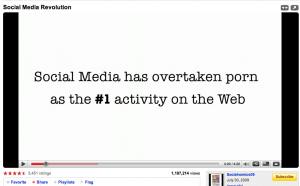Among the most important benefits of social media tools are their ease of use. While updating a static Web site can be onerous, and video shooting, editing and distribution also can be complicated, the beauty of blogs, Flip cameras (or Kodaks) and YouTube is the nimble authenticity they bring to communication.
Of course, it’s possible to develop bureaucratic processes that will completely erase the advantages of social media. By trying to fix perceived shortcomings of the standard social media tools by upgrading production values, you can lose their freshness and authenticity.
Don’t do that. Don’t complicate things.
To encourage you in this, I’m sharing a couple of examples from our Mayo Clinic experience, in which the nimbleness of social media tools enabled us to capture compelling stories that formerly would have been impossible, or at least impractical.
Exhibit A: Sharing Patient Stories
On Friday, September 18, 200, I received a late-afternoon call from one of our Mayo Clinic cardiologists, Dr. Michael Ackerman, telling me about an infant patient from the San Francisco area he had been evaluating. The call came about 3 p.m., and within an hour I was interviewing Trevor’s mom in the courtyard near their hotel. Here’s what she had to say:
See the rest of Brenda’s story.
The Kings were leaving for home the next morning, and if I had been unable to shoot the interview, we would not have been able to tell this story. Getting one of our professional videographers to break away on short notice would have added one more complicating factor to the equation, making it unlikely to work. But with the Flip, we captured the authentic moment.
Here’s another story from Sharing Mayo Clinic about Dr. Ackerman that will warm your heart. It doesn’t necessarily fit the theme of this post, but you should check it out anyway.
Exhibit B: Late-Breaking News
On Tuesday, June 3, 2008 at 8:45 a.m. I got some good news and some bad news. The good news was that one of our Mayo Clinic researchers, Dr. Victor Montori, had a paper being published in a major medical journal, Journal of the American Medical Association, or JAMA.
The bad news: the paper was being published that day, and was coming “off embargo” in just over six hours. This left us no time to prepare a formal news release or shoot and edit broadcast-quality video. In the era before our Mayo Clinic News Blog, we would have had no good options for calling attention to this research.
But since we had the blog and the Flip camera, called Dr. Montori and interviewed him at 10:20. By 11:55 we had uploaded the video to YouTube and had also prepared this blog post about the diabetes research. We sent “pitches” by email and Facebook to some journalists starting at noon, and the next day the Wall Street Journal Health Blog carried the story and embedded this video from our YouTube channel:
These are just two case studies of the practical advantages of using social media tools as more efficient and effective means of doing your work, if you don’t purposefully complicate things.
How have you used the Flip or similar tools for authentic storytelling?
